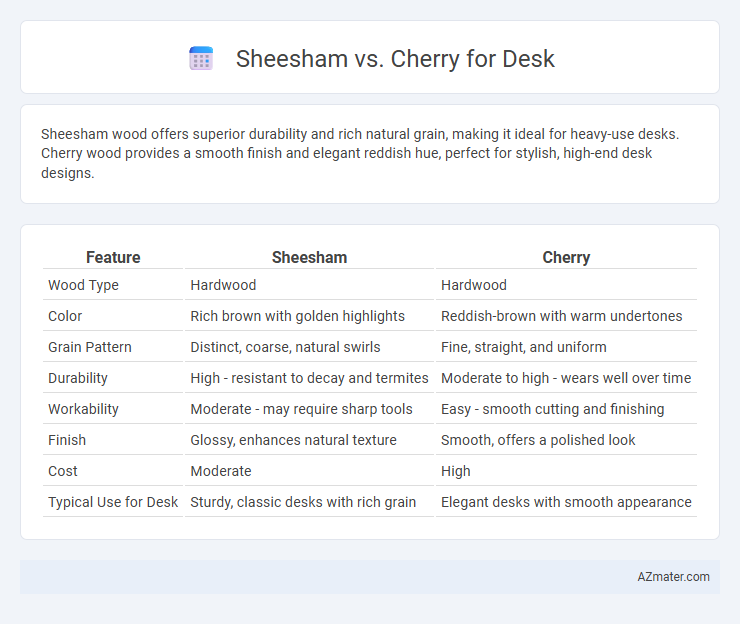Sheesham wood offers superior durability and rich natural grain, making it ideal for heavy-use desks. Cherry wood provides a smooth finish and elegant reddish hue, perfect for stylish, high-end desk designs.
Table of Comparison
| Feature | Sheesham | Cherry |
|---|---|---|
| Wood Type | Hardwood | Hardwood |
| Color | Rich brown with golden highlights | Reddish-brown with warm undertones |
| Grain Pattern | Distinct, coarse, natural swirls | Fine, straight, and uniform |
| Durability | High - resistant to decay and termites | Moderate to high - wears well over time |
| Workability | Moderate - may require sharp tools | Easy - smooth cutting and finishing |
| Finish | Glossy, enhances natural texture | Smooth, offers a polished look |
| Cost | Moderate | High |
| Typical Use for Desk | Sturdy, classic desks with rich grain | Elegant desks with smooth appearance |
Introduction to Sheesham and Cherry Wood
Sheesham wood, also known as Indian Rosewood, is prized for its dense grain, rich brown hues, and natural durability, making it an excellent choice for desks requiring strength and long-lasting appeal. Cherry wood features a smooth texture with a warm reddish-brown color that deepens with age, offering a classic and elegant appearance ideal for refined workspaces. Both woods provide unique aesthetics and robust construction, catering to different stylistic preferences and functional needs in desk furniture.
Wood Appearance and Grain Patterns
Sheesham wood features rich, dark brown hues with natural golden streaks, creating a striking contrast and depth ideal for desks with a classic, elegant look. Cherry wood presents a warm reddish tone that deepens over time, boasting a smooth, fine grain pattern that provides a consistent and refined surface texture. The distinctive grain of Sheesham is more pronounced and varied, while Cherry's grain is subtler, offering a sleek and polished appearance for modern desk designs.
Durability and Longevity
Sheesham wood is renowned for its exceptional durability and natural resistance to decay, making it highly suitable for long-lasting desks. Cherry wood, while slightly softer, offers excellent longevity with a smooth finish that ages beautifully over time, developing a rich patina. Both woods provide sturdy, durable options, but Sheesham's denser grain structure typically ensures greater resistance to wear and environmental factors.
Workability and Ease of Crafting
Sheesham wood offers exceptional workability due to its medium density and natural oils, making it resistant to wear and easy to carve for intricate desk designs. Cherry wood, prized for its fine grain and smooth texture, allows seamless sanding and finishing while developing a rich patina over time. Both woods provide reliable durability, but Sheesham's toughness makes it ideal for heavy-use desks, whereas Cherry excels in projects requiring refined detailing.
Cost Comparison
Sheesham wood desks generally cost more than cherry wood desks due to Sheesham's durability and rich grain patterns, which increase its market value. Cherry wood desks offer a more affordable option while still providing a smooth finish and attractive reddish hue. The price difference also reflects Sheesham's superior resistance to wear and moisture, justifying the higher investment for long-term use.
Maintenance and Care Requirements
Sheesham wood requires minimal maintenance, needing occasional polishing and protection from excessive moisture to preserve its rich grain and durability. Cherry wood demands more frequent care, including regular cleaning and conditioning to prevent darkening and surface wear due to its softer nature. Both woods benefit from avoiding direct sunlight and using coasters or mats to maintain the desk's finish and longevity.
Environmental Impact and Sustainability
Sheesham wood, sourced primarily from Dalbergia species native to India, is renowned for its durability and natural resistance to pests, but concerns about overharvesting and habitat loss raise sustainability issues unless certified by FSC or similar organizations. Cherry wood, derived from Prunus serotina trees common in North America, offers a slower growth rate but is often harvested from managed forests with better reforestation practices, enhancing its environmental profile. Choosing Sheesham vs Cherry desks requires evaluating factors like carbon footprint, forest management certifications, and local ecosystem impact to ensure eco-friendly furniture decisions.
Weight and Structural Strength
Sheesham wood, also known as Indian Rosewood, is significantly heavier and denser than Cherry wood, providing excellent structural strength ideal for durable desks. Its high density contributes to superior resistance against dents and scratches, making it a preferred choice for heavy-duty furniture. Cherry wood, while lighter and easier to maneuver, offers moderate strength but tends to develop a smooth patina with time, which enhances aesthetic appeal rather than rugged durability.
Common Desk Styles Using Sheesham vs Cherry
Sheesham and Cherry woods are popular choices for common desk styles such as executive, writing, and computer desks. Sheesham offers a rich, darker grain with natural oils that provide durability and resistance to wear, making it ideal for executive desks requiring a sturdy build. Cherry wood is favored for its smooth texture and warm reddish tones that deepen with age, enhancing the aesthetic appeal in writing and computer desks with elegant, polished finishes.
Which Wood is Best for Your Desk?
Sheesham wood, known for its rich grain patterns and durability, offers a robust and long-lasting surface ideal for heavy use desks, while cherry wood provides a smoother finish with a warm reddish hue that develops a desirable patina over time. Sheesham's natural resistance to decay and insects makes it suitable for high-traffic areas, whereas cherry's fine texture and ease of polishing cater to elegant, refined office environments. Choosing the best wood depends on whether durability and rustic charm or aesthetic warmth and smoothness are more important for your desk's functionality and style.

Infographic: Sheesham vs Cherry for Desk
 azmater.com
azmater.com